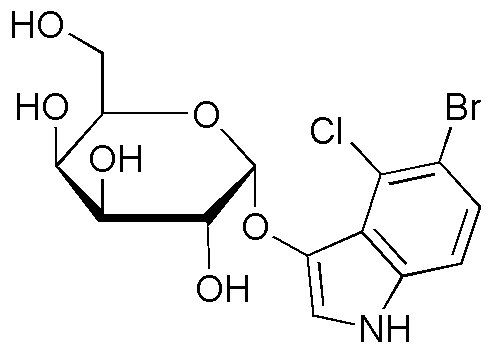5-Bromo-4-chloro-3-indolyl-a-D-galactopyranoside is widely utilized in research focused on:
- Biochemical Assays: This compound serves as a substrate in enzyme assays, particularly for identifying and studying the activity of galactosidases, which are crucial in various biological processes.
- Microbial Research: It is employed to differentiate between bacterial species based on their ability to metabolize galactosides, aiding in microbiological studies and diagnostics.
- Plant Biology: Researchers use it to investigate gene expression in plants, particularly in studies related to carbohydrate metabolism and signaling pathways.
- Pharmaceutical Development: The compound is valuable in drug discovery processes, especially in screening for new therapeutic agents that target specific enzymes.
- Food Industry Applications: It can be applied in food microbiology to assess the quality and safety of dairy products by detecting specific bacterial strains.
General Information
Properties
Safety and Regulations
Applications
5-Bromo-4-chloro-3-indolyl-a-D-galactopyranoside is widely utilized in research focused on:
- Biochemical Assays: This compound serves as a substrate in enzyme assays, particularly for identifying and studying the activity of galactosidases, which are crucial in various biological processes.
- Microbial Research: It is employed to differentiate between bacterial species based on their ability to metabolize galactosides, aiding in microbiological studies and diagnostics.
- Plant Biology: Researchers use it to investigate gene expression in plants, particularly in studies related to carbohydrate metabolism and signaling pathways.
- Pharmaceutical Development: The compound is valuable in drug discovery processes, especially in screening for new therapeutic agents that target specific enzymes.
- Food Industry Applications: It can be applied in food microbiology to assess the quality and safety of dairy products by detecting specific bacterial strains.
Documents
Safety Data Sheets (SDS)
The SDS provides comprehensive safety information on handling, storage, and disposal of the product.
Product Specification (PS)
The PS provides a comprehensive breakdown of the product’s properties, including chemical composition, physical state, purity, and storage requirements. It also details acceptable quality ranges and the product's intended applications.
Certificates of Analysis (COA)
Search for Certificates of Analysis (COA) by entering the products Lot Number. Lot and Batch Numbers can be found on a product’s label following the words ‘Lot’ or ‘Batch’.
*Catalog Number
*Lot Number
Certificates Of Origin (COO)
This COO confirms the country where the product was manufactured, and also details the materials and components used in it and whether it is derived from natural, synthetic, or other specific sources. This certificate may be required for customs, trade, and regulatory compliance.
*Catalog Number
*Lot Number
Safety Data Sheets (SDS)
The SDS provides comprehensive safety information on handling, storage, and disposal of the product.
DownloadProduct Specification (PS)
The PS provides a comprehensive breakdown of the product’s properties, including chemical composition, physical state, purity, and storage requirements. It also details acceptable quality ranges and the product's intended applications.
DownloadCertificates of Analysis (COA)
Search for Certificates of Analysis (COA) by entering the products Lot Number. Lot and Batch Numbers can be found on a product’s label following the words ‘Lot’ or ‘Batch’.
*Catalog Number
*Lot Number
Certificates Of Origin (COO)
This COO confirms the country where the product was manufactured, and also details the materials and components used in it and whether it is derived from natural, synthetic, or other specific sources. This certificate may be required for customs, trade, and regulatory compliance.


